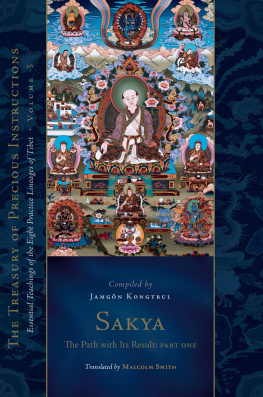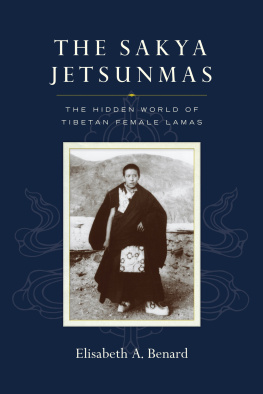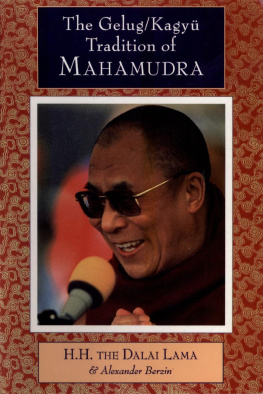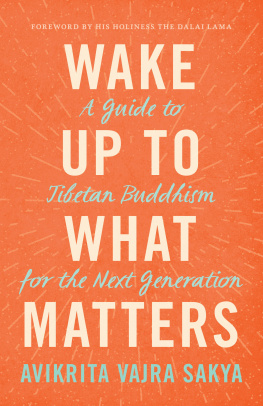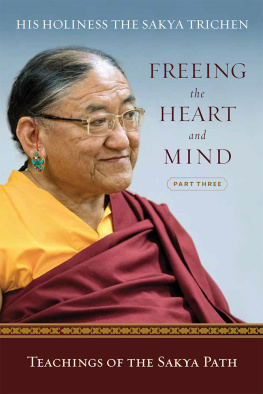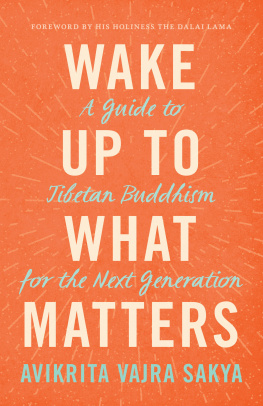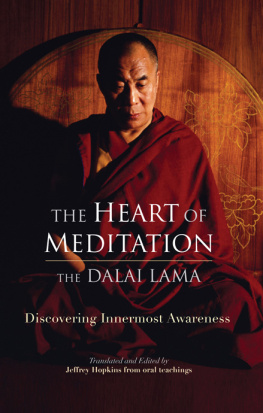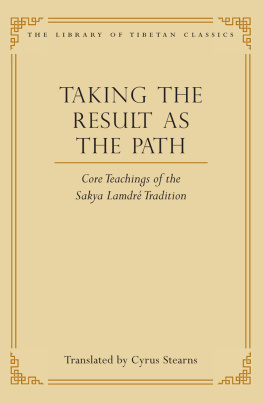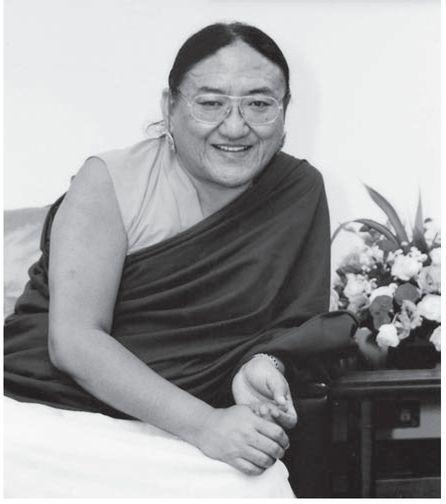Table of Contents
His Holiness the Forty-First Sakya Trizin
Preface
EVERY STRUCTURE needs a strong foundation. So, too, study and practice of the precious Dharma needs a strong foundation in order to progress through the various stages and levels. Without a strong foundation, it is very difficult to understand and achieve the levels of the Dharma. The Vajrayanaor tantricpath has foundations that it shares with all Buddhist paths, and it has foundations that are unique to Vajrayana. Of these, it is most essential to master the shared foundations.
The mind is like an untamed horse galloping aimlessly in the wilderness of cyclic existence. Contemplation is the saddle to train the mind, and the holy Dharma is the rein to guide it upon the path to enlightenment. Therefore, it is of utmost importance to study and reflect upon the foundational teachings of Lord Shakyamuni Buddha and the commentaries on those teachings that were taught by great accomplished masters in ancient times.
At the same time it is also essential to learn the life stories of these great masters and to absorb the valuable principles within them into our daily lives. This will help us to turn our minds toward the Dharma and to set out steadfastly on the Dharma path, thereby enabling us to help other mother sentient beings achieve peace, happiness, and liberation.
I am very pleased to offer this first book of a Buddhist curriculum prepared for English-speaking students who wish to study the authentic Dharma from the great masters of Tibet just as it has been taught for centuries by the Sakya orders greatest teachers. Although students may live at a distance in time or space from these great masters, careful study of this book will provide them with a strong foundation.
The Dharma teachings chosen for this curriculum are authentic and very traditional, yet they are offered in a modern format, with a study guide available at www.hhthesakyatrizin.org. After thoroughly studying these great teachings, you may wish to take the online examination on the website to measure your progress.
Learning about the Dharma proceeds through the stages of study, contemplation, and then meditation. After learning these teachings and thinking carefully about them, it is important to practice the meditations described here again and again. I believe this book will prove very beneficial for those who wish to learn about Buddhadharma in depth on their own, in their leisure time.
I thank Khenpo Kalsang Gyaltsen and Ani Kunga Chodron for editing this book and compiling the study guides, and Reverend Jamyang Tharchin for additional assistance. I wish this project every success and pray that these teachings will help to open the minds of those who seek the Dharma.
May the blessings of the Triple Gem be with you now and always.
His Holiness the Forty-First Sakya Trizin
PART ONE
Entering the Dharma Path
His Holiness Sakya Trizin
The first section of this book is a teaching I gave to a young friend who requested from me an introduction to Buddhism. In order to set him properly on the path, I explained the basics of Buddhist teachings with a special focus on the Buddhas most famous teaching, the four noble truths.
Introduction to Buddhism
HIS HOLINESS SAKYA TRIZIN
WHATEVER PRACTICE WE DO, the direction in which it will lead us depends on our primary motivation. Since having an improper motivation is very harmful, cultivating a suitable motivationthe highest motivationis of utmost importance. The highest motivation for receiving teachings is to attain full enlightenment not just for the sake of ourselves but for the sake of all sentient beings. Thus, think that you are receiving these teachings in order to accomplish this altruistic aim.
The basic progression of practice in the schools of Buddhismthe Theravada, Mahayana, and Vajrayana schoolsis to first establish a basis of sound moral conduct, then to study, contemplate, and meditate. All Buddhist schools begin with the establishment of sound moral conduct. Therefore, the very first thing is to receive the teachings with the right motivation and the right conduct. This means we receive them with a physical, verbal, and mental attitude of respect. Receiving teachings in this way is of great benefit.
According to Buddhist sutras, every sentient being, not only human beings but every sentient being, from tiny insects up to even the highest gods, possesses buddha nature. Buddha nature is the true nature of our minds. It is pure. It is never stained by obscurations. Therefore, every living being, when it meets with the right causes, right conditions, and right methods, has the potential to attain perfect enlightenment, buddhahood.
But at the moment we do not see the true nature of our minds. Instead, our minds are completely deluded by two types of obscurations: obscurations that are defilements and obscurations of knowledge. As long as we have these obscurations, we are not free. Our path to buddhahood is blocked, and we are instead mired in what is known as samsara. Samsara is our deluded universe, the cycle of existence that goes on and on.
We have both a physical body and a mind. Of course we know where the physical body came from, how it developed, and how it is maintained. We can see it with our eyes, touch it with our hands, and can describe its size, color, shape, and so on. Eventually, when we leave this world, the physical body will be cremated, buried, or something else. But the mind is something very different. The mind is something that we cant see with our eyes; we cant touch with our hands; we cant describe in terms of shape, color, or size. Where does this mind come from? It cannot come from the body, which is something visible, because the mind is invisible. An invisible mind cannot rise from a visible physical entityfrom matter or from the elements.
The mind also has to have some kind of continuity. It cannot come from nothing. Because of this we can establish or prove that we had a mind before we took our present physical body. We must have had a previous or past life. And before that life, we had another past life and so on. There is no point in time that we can identify as the beginning of a particular persons mind. Our minds are beginningless.
It is one of the wonders of life that from beginningless time until now, this same mind has continued. Of course it changes from moment to moment, but it is still in some sense the same mind. Never stopping, it continues even today in our present human form, but when we leave this world, it will enter another body in another world, in another place, in another family. This goes on and on. Therefore, our universe, or samsara, is like a circle or a wheel that turns and turns without end. Because samsara is like a wheel, it is called the wheel of life , and every segment of the wheel of life is characterized by some form of suffering. The Buddha taught the way to escape the wheel of life.


